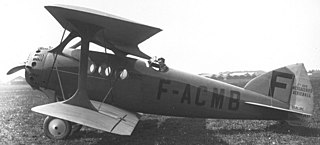This article needs additional citations for verification .(March 2017) |
Air Navigation and Engineering Company Limited was a British aircraft manufacturer from its formation in 1919 to 1927.
This article needs additional citations for verification .(March 2017) |
Air Navigation and Engineering Company Limited was a British aircraft manufacturer from its formation in 1919 to 1927.
The company was formed in 1919 when the Blériot & SPAD Manufacturing Company Limited was renamed. The company was based at Addlestone Surrey.
The Blériot aircraft company had opened a factory at Addlestone during World War I to make SPAD and Avro aircraft and in 1919 the company became the Air Navigation and Engineering Company Limited. One of the first products was a cyclecar designed by Herbert Jones and W.D. Marchant called the Blériot-Whippet.
In 1922 the company built a 10-seat biplane airliner (the Handasyde H.2) on behalf of the Handasyde Aircraft Company Limited. The company built a number of light aircraft, the first designed by W.S. Shackelton was the ANEC I flying in 1923. The aircraft were built at Addlestone then roaded to Brooklands for flight testing. The company stopped producing aircraft in 1926 and closed in 1927.

Blackburn Aircraft Limited was a British aircraft manufacturer that concentrated mainly on naval and maritime aircraft during the first part of the 20th century.

Louis Charles Joseph Blériot was a French aviator, inventor, and engineer. He developed the first practical headlamp for cars and established a profitable business manufacturing them, using much of the money he made to finance his attempts to build a successful aircraft. Blériot was the first to use the combination of hand-operated joystick and foot-operated rudder control as used to the present day to operate the aircraft control surfaces. Blériot was also the first to make a working, powered, piloted monoplane. In 1909 he became world-famous for making the first airplane flight across the English Channel, winning the prize of £1,000 offered by the Daily Mail newspaper. He was the founder of Blériot Aéronautique, a successful aircraft manufacturing company.

SPAD was a French aircraft manufacturer active between 1911 and 1921. Its SPAD S.XIII biplane was the most produced French fighter airplane of the First World War.
Sir W. G. Armstrong Whitworth Aircraft Company, or Armstrong Whitworth Aircraft, was a British aircraft manufacturer.

Farman Aviation Works was a French aircraft company founded and run by the brothers Richard, Henri, and Maurice Farman. They designed and constructed aircraft and engines from 1908 until 1936; during the French nationalization and rationalization of its aeronautical industry, Farman's assets were assigned to the Société Nationale de Constructions Aéronautiques du Centre (SNCAC).
The Janoir was a French motorcycle manufactured from 1919 until 1922 in Saint-Ouen. The few that were made were 965 cc flat twins.

The Blériot-SPAD S.34 was a French twin-seat, single-engine biplane flight training aircraft designed in 1920. The side-by-side seating arrangement was unique for its time. 150 aircraft were built, 125 for the French Air Force, who used them until 1936.

Blériot Aéronautique was a French aircraft manufacturer founded by Louis Blériot. It also made a few motorcycles between 1921 and 1922 and cyclecars during the 1920s.

The Blériot-Whippet was a British 4 wheeled cyclecar made from 1920 to 1927 by the Air Navigation and Engineering Company based in Addlestone, Surrey.

The ANEC I and ANEC II were 1920s British single-engine ultralight aircraft designed and built by Air Navigation and Engineering Company Limited at Addlestone Surrey. One was privately constructed in Brisbane, Australia.

The ANEC III was a 1920s British six-seat passenger and mail carrier aircraft built by Air Navigation and Engineering Company Limited at Addlestone, Surrey.

The ANEC IV Missel Thrush was a 1920s British two-seat light aircraft built by Air Navigation and Engineering Company Limited at Addlestone Surrey.

The Bleriot-SPAD S.33 was a small French airliner developed soon after World War I. The aircraft was a biplane of conventional configuration whose design owed much to the Blériot company's contemporary fighter designs such as the S.20. Four passengers could be accommodated in an enclosed cabin within the monocoque fuselage, and a fifth passenger could ride in the open cockpit beside the pilot. A great success, the S.33 dominated its field throughout the 1920s, initially on CMA's Paris-London route, and later on continental routes serviced by Franco-Roumaine.

The Handasyde glider was a single-seat monoplane glider, designed specifically for the first British gliding competition held at Itford Hill in 1922, an endurance event. It finished in second place to a French tandem-wing machine.
Eric Longden was a British cyclecar brand manufactured from 1920 to 1927, originally by the Australian racing driver Eric Longden, and from 1922 by the Air Navigation and Engineering Company from Addlestone (Surrey). ANEC also built the Blériot-Whippet.

The Wibault company or Société des Avions Michel Wibault was a French aircraft manufacturing company. Its workshops were located in Billancourt, in the Paris area.

The Handasyde H.2 was a six seat airliner built in the UK in the early 1920s. Only one was completed.

The Blériot-Spad S.45 was a large, four engine French airliner which appeared at the 1921 Paris Salon. It could carry fifteen passengers or be adapted as a bomber.